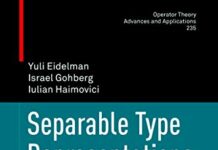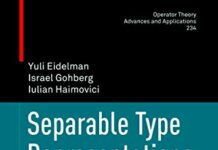
Ebook Info
- Published: 2004
- Number of pages: 322 pages
- Format: PDF
- File Size: 10.04 MB
- Authors: Yuli Eidelman
Description
This textbook provides an introduction to the methods and language of functional analysis, including Hilbert spaces, Fredholm theory for compact operators, and spectral theory of self-adjoint operators. It also presents the basic theorems and methods of abstract functional analysis and a few applications of these methods to Banach algebras and the theory of unbounded self-adjoint operators. The text corresponds to material for two semester courses (Part I and Part II, respectively) and is essentially self-contained. Prerequisites for the first part are minimal amounts of linear algebra and calculus. For the second part, some knowledge of topology and measure theory is recommended. Each of the 11 chapters is followed by numerous exercises, with solutions given at the end of the book. The text is ideal for a one-year course. It will also provide a sound basis for further study. It is suitable for graduate students and researchers interested in operator theory and functional analysis.
User’s Reviews
Editorial Reviews: Review This book contains a wealth of material. Each chapter concludes with a comprehensive set of exercises that serve to illustrate the theory. Solutions to the exercises are given in the final section. –Mathematical ReviewsThis is a gentle introduction to functional analysis that is clearly written and comes with detailed, elegant and effective proofs and well-chosen examples. … This book is written with great care and with much sympathy to the reader. It is pleasant to read… It is simply a good book to learn the foundations of functional analysis. –Zentralblatt MATHEach chapter includes exercises, in total 195 of the them, all provided with solutions at the end of the book. The text is as self-contained as possible… The authors have taken special care to be brief and not to overload the students with the enormous amount of information available on the subject. –EMS Newsletter
Reviews from Amazon users which were colected at the time this book was published on the website:
⭐One problem that most functional analysis books have is that they flop around in unmotivated abstraction. They spend a great deal of time talking about F spaces, Frechet spaces, topological vector spaces, and what not, all the while it isn’t particularly clear to a student just coming out of a real analysis class why any of these spaces are natural. This book, on the other hand, sticks entirely to Hilbert Spaces and Banach spaces, whose main examples students will have already seen. This is a specific example of a general trend throughout this book: providing an accessible, concrete viewpoint of its topics.This may not seem like a very big deal when talking about various spaces and their definitions, but it makes all the difference in the world when talking about spectral theory and many of the powerful theorems such as the open mapping theorem and the Hahn-Banach theorem. The order in which this book presents its topics is deceptively clever. This book is incredibly sparse on explicit explanation of how to think, but the order in which the ideas are presented invite the student to make connections themselves and to think deeply about the definitions. As referenced before, the student is able to grasp the ideas easily because the book presents its most difficult ideas in (unique?) ways that are incredibly easy to grasp.Here is an example: many books will build up spectral theory by first considering C* algebras. However, to discuss the spectral theory of self-adjoint or unitary operators, you don’t need that heavy machinery. This book considers polynomials of operators, and then continuous functions of operators by passing through monotone limits. Understanding how the continuous functions affect the spectrum of the operator is then considered. Finally, the spectral decomposition of a self-adjoint operator is proved, and passing the continuous function through the spectral integral becomes obvious from their construction. It is this unique presentation of ideas that makes this the best introductory functional book.Just because this book has a concrete viewpoint doesn’t mean this book isn’t hard. This book’s difficulty grows quite a bit after chapter 3. Any student who wants to go through this book is going to have to work. Hard. As I said before, this book doesn’t provide much in the way of hand holding or explanation. It states the facts, and then moves on to new facts. The thing that anchors the student’s understanding and is the reason they will be able to go through this book is the concreteness. This book’s sparsity is also why it crams a whole lot of material into a mere 200 pages. A student who works entirely through this book won’t really have need to read a book like Rudin’s Functional or Lax’s. Sure, there are some topics here and there that they leave out (spectral theory for normal operators), but this book provides a solid enough foundation to where students can go pick that stuff up by reading it in their free time.This book also has many problems, which is great. Many of them are interesting and important (they ask to you find the spectra of specific integral operators instead of just proving more things about them). However, the reason I have taken off a star is that this book has many typos. They are universally trivial (in that they aren’t serious mathematical errors). They will not confuse the reader, but they’re there. Some chapters average at least one obvious typo per page.This book is very good, but it isn’t perfect. Either way, I recommend this book to all of my friends who want a first book in functional analysis.
⭐I think it is a very good book who is starting in functional analysis. I am studying by myself and it has been very usefull. In spite of be an introduction it will deep in the topics and the solved exercise is very important thing. However the book has a typos.
⭐This book is very good. It is well organized, gives the solutions to problems, well written with all basic facts.
⭐Delivered fine. Great condition and delivered well on time. Wish my professor wasn’t using this text, however. Not the best handling of the material that I’ve seen so far.
⭐
⭐
⭐
Keywords
Free Download Functional Analysis: An Introduction (Graduate Studies in Mathematics) in PDF format
Functional Analysis: An Introduction (Graduate Studies in Mathematics) PDF Free Download
Download Functional Analysis: An Introduction (Graduate Studies in Mathematics) 2004 PDF Free
Functional Analysis: An Introduction (Graduate Studies in Mathematics) 2004 PDF Free Download
Download Functional Analysis: An Introduction (Graduate Studies in Mathematics) PDF
Free Download Ebook Functional Analysis: An Introduction (Graduate Studies in Mathematics)

